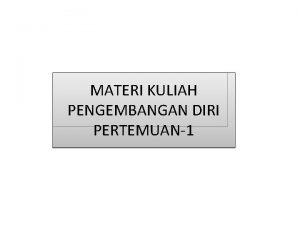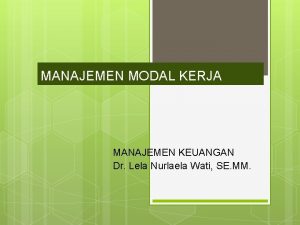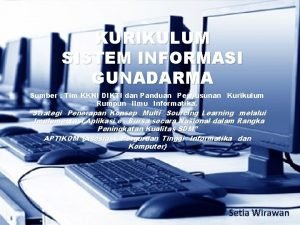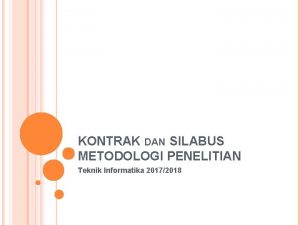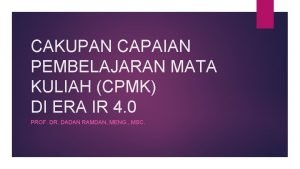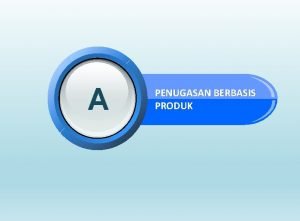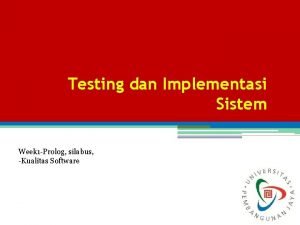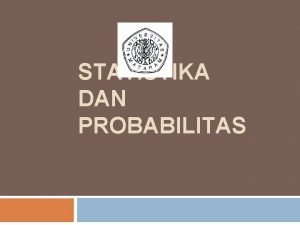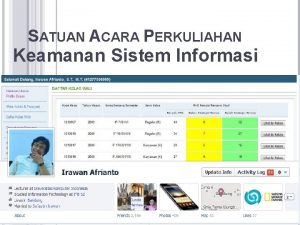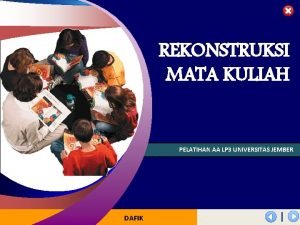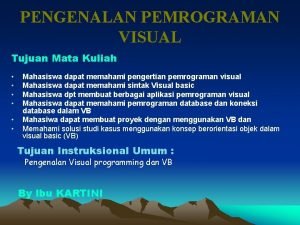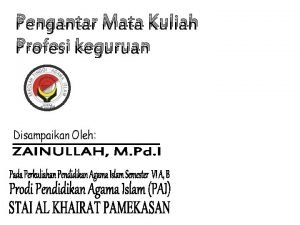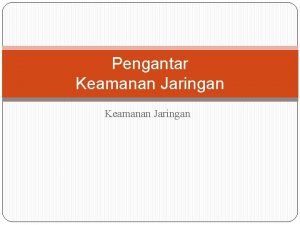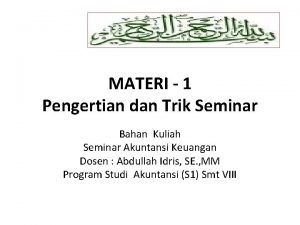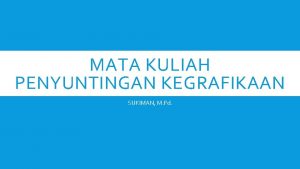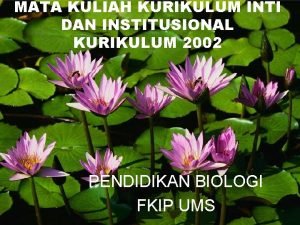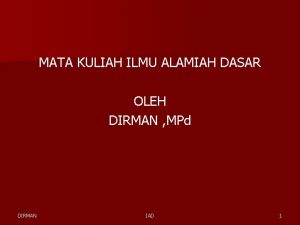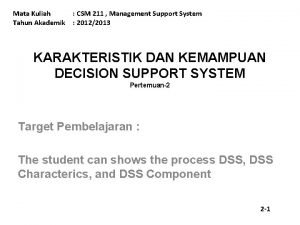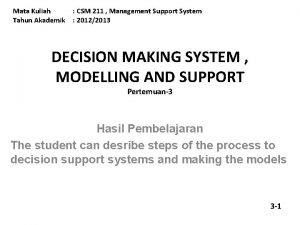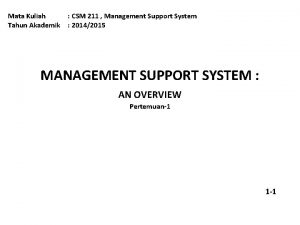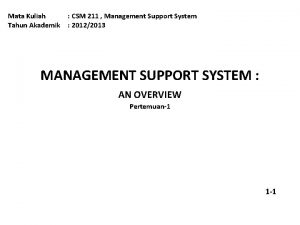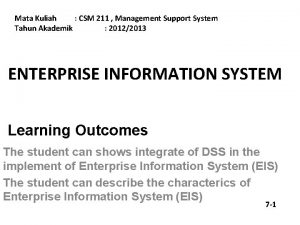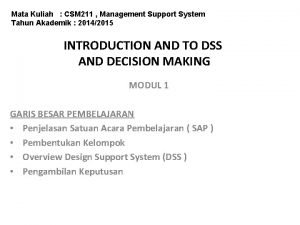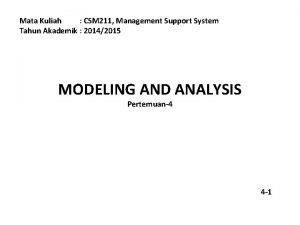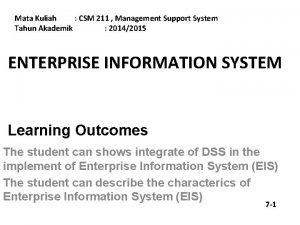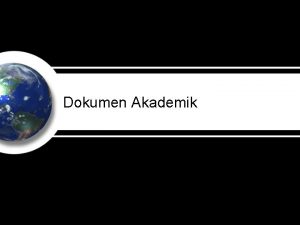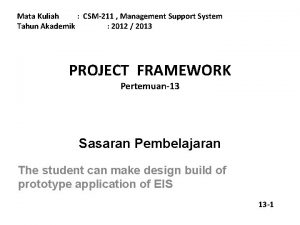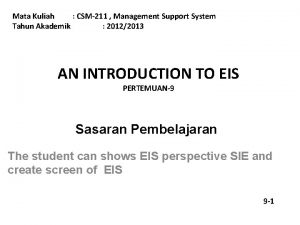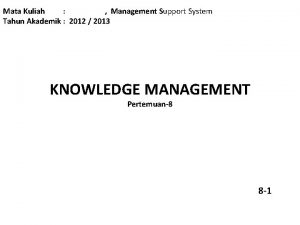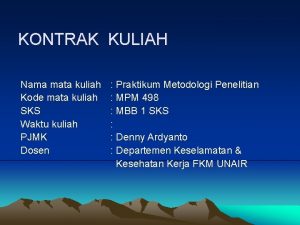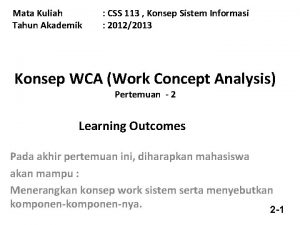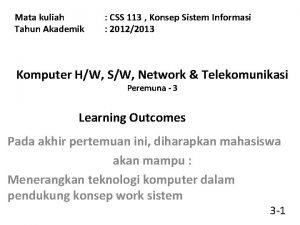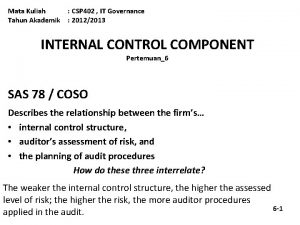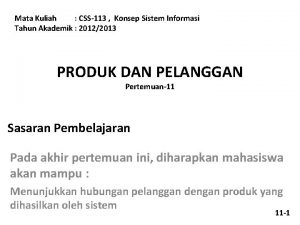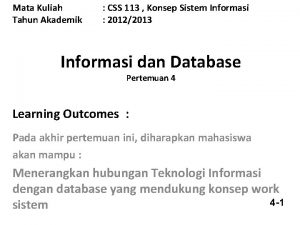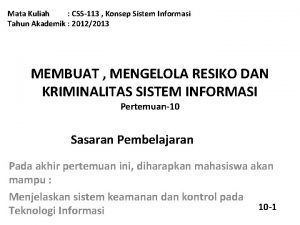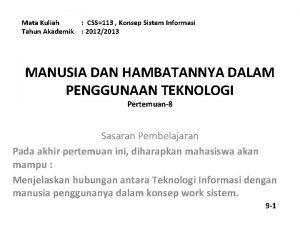Mata Kuliah Tahun Akademik CSM 211 Management Support


























- Slides: 26

Mata Kuliah Tahun Akademik : CSM 211 , Management Support System : 2012/2013 DECISION MAKING SYSTEM , MODELLING AND SUPPORT Pertemuan-3 Hasil Pembelajaran The student can desribe steps of the process to decision support systems and making the models 3 -1

Sasaran Pembelajaran • Understand the foundations, definitions, and capabilities of decision support systems • Describe DSS components and technology levels • Explain the importance of database and database management • Explain the importance of models and model management • Understand how DSS are developed • Understand DSS success and failure factors • Understand collaboration and group support systems and their impacts • Understand knowledge management systems and their impacts 3 -2

CASE STUDY : STANDAR MOTOR PRODUCT SHIFTS GEARS INTO TEAM BASED DECISION MAKING The making decision ussualy have do into the team. The goals to increasing ability of group to getting output more good of the decisions. Each member of the team have responsibility to choice many alternative. The result decision can influence to change operation and have relationship by the others. Including the thingking process to search data and model of problems. Therefore the needed feedback 3 -3

Pertanyaan : • Why do you think in many organization are paid to di, rather than to think? • Why do you think productivity dropped in the first year of the team based program? • Why is leadership commitement to change important? • How are decision handled in the team approach: – – How do teams identify problems How do teams approach problems How do teams choose solutions How do teams implement solutions • How di team handle conflicting objectives 3 -4

Decision Making - Definitions • The process to choise of many alternative to achivement goals • Phase Decision Making : – – Intelligence Design Choice Implementation 3 -5

Systems Definition Systems : • A collection of objects such as people, resources, concepts, procedures intended to perform an identifiable function to serve a goal Systems Model : • Input-Process-Output-Feedback • Separate from environment of the systems • Systems determined of system boundary 3 -6

THE SYSTEM AND ITS ENVIRONMENT 3 -7

MODELS DEFINITION : • A simplified representation or abstraction of reality • Usually simplified because reality is too complex to describe exactly and much of complexity is actually irrelevant on solving the spesific problem • Classified : – – – Iconic Models (abstract type of model) Analog Models (real system but doesnot look like it) Quantitative/Mathematical Models (Abstract models to representation complexity relationship) 3 -8

THE STRUCTURE OF A SYSTEM • • INPUTS PROCESSES OUTPUTS FEEDBACK PHASE OF Decision Making and the Web 1. 2. 3. 4. INTELLIGENCE DESIGN CHOICE IMPLEMENTATION 3 -9

INTELLIGENCE PHASE Intelligence in decision making involves scanning the environment, eitheir intermittently or continuously. • • • Problem (or Opportunity) Identification Problem classification Programmed versus Nonprogrammed Problems Problem Decomposition Problem Ownership 3 -10

DESIGN PHASE Design Phase involves finding or developing and analyzing possible courses of action • Selection of a principle of choice • Normative Models • Sub-optimization • Descriptive Models • Good Enough or satisficing • Developing (Generating) alternatives • Measuring outcomes • Scenarios • Possible Scenarios • Errors in decision Making 3 -11

Classes of descriptive model include • • • Complexity inventory decisions Environmental impact analysis Financial planning Information flow Markov Analysis (predictions) Scenario Analysis Simulation (alternative types) Technological Forecasting Waiting line (queuing) management) 3 -12

THE CHOICE PHASE • Choice is the critical act of decision making. The choice phase is the one is which the actual decision is made and where the commitment to follow a certain course of action is made • The boundaryh between the design and choice phase is often unclear because certain activities can be performed during both of them and because one can return frequently from choice activities to design activities 3 -13

THE IMPLEMENTATION PHASE • The implementation of a proposed solution to a problem is in effect, the initiation of a few order of thins, or the introduction of change • The definition of implementation is somewhat complicated because implementation is a long, involved process with vague boundaries 3 -14

HOW DECISION ARE SUPPORTED 3 -15

HOW DECISION ARE SUPPORTED • • Support for the intelligence phase Support for the design phase Support for the choice phase Support for the implementation phase: – Making the decision happen – New technology support for decision making 3 -16

Phase 1 : ü ü ü INTELLIGENCE Identification environment Analysis goals of organization Collection data and fact finding Identification problems Categories problems (programable – no programable) Evaluation stakeholder and responsible of problems 3 -17

Phase 2 ü ü ü : DESIGN Development alternative of many action Analysis the best solution Build models test study feasilibity Validation result Determine choise principles : - objectives - models - Risk - Criteria 3 -18

Phase 3 : CHOICE Critics and crusial problem to make the decision Choice, evaluation and recommendation Choice principle describe approach the solutions model : Ø Ø Optimization Rasionalization Suboptimization Descriptive models 3 -19

OPTIMIZATION Normative Model by shows all good alternative Steps : • Determine the highest goals and resources to achievement (example : how much the highest profitable if the investment 10 M ? ) • Finding alternative by calculate the highest rasio between goal of cost or optimal produktivitas • Finding alternative by the lower cost and efficient to achievement of the goal 3 -20

RASIONALIZATION Normative Model based on the assumption : • The maximal/increase goal, and the other function have to reducing • Each action have risk and consequences • The alternative choiced based on the best upto the not good 3 -21

SUBOPTIMIZATION • • Normative Model to decision support by consider impact of each choice to comprehensive activities on the organization Example : suboptimization, making decision to marketing department on organization without consider activities other function organization 3 -22

DESCRIPTIVE MODELS • Extremely useful in DSS for investigation the consequenses of various alternative courses of action under different configuration of input and processes 3 -23

DESCRIPTIVE MODELS • Class of Descriptive Models : – – – – – Complex inventory decisions Environment impact analysis Financial planning Information flow Markov analysis (predictions) Scenario analysis Simulation (alternative types) Technological forecasting Waiting line (queuing) management 3 -24

DEVELOPING/GENERATE ALTERNATIVE • • • Generate alternative by automatics or manuals Can parallel and needed the spesific information Making scenario Evaluation by the heuristic The result influence achievement goal 3 -25

Phase 4 : IMPLEMENTATION • • The solution choice to implement Not necessarily the implementation because : - Resistance the user of the change - Training to the user is not involved - The Lack supporting of top management ===== thanks 4 your attention ===== 3 -26
 Mata kuliah etika profesi
Mata kuliah etika profesi Mata kuliah pengembangan diri
Mata kuliah pengembangan diri Erd kuliah
Erd kuliah Matkul ekonomi pembangunan ub
Matkul ekonomi pembangunan ub Mata kuliah pelayanan prima
Mata kuliah pelayanan prima Contoh soal modal kerja mata kuliah manajemen keuangan
Contoh soal modal kerja mata kuliah manajemen keuangan Kurikulum sistem informasi gunadarma
Kurikulum sistem informasi gunadarma Mata kuliah metode penelitian teknik informatika
Mata kuliah metode penelitian teknik informatika Mata kuliah ilmu kelautan unpad
Mata kuliah ilmu kelautan unpad Deskripsi mata kuliah ekonomi mikro
Deskripsi mata kuliah ekonomi mikro Mata kuliah creative writing
Mata kuliah creative writing Cpmk
Cpmk Cjr mata kuliah kewirausahaan
Cjr mata kuliah kewirausahaan Mata kuliah testing dan implementasi sistem
Mata kuliah testing dan implementasi sistem Mata kuliah probabilitas dan statistika
Mata kuliah probabilitas dan statistika Silabus sejarah pendidikan islam
Silabus sejarah pendidikan islam Mata kuliah keamanan sistem informasi
Mata kuliah keamanan sistem informasi Rekonstruksi mata kuliah
Rekonstruksi mata kuliah Matkul ekonomi islam ub
Matkul ekonomi islam ub Tujuan mata kuliah
Tujuan mata kuliah Mata kuliah profesi keguruan
Mata kuliah profesi keguruan Materi tentang keamanan jaringan
Materi tentang keamanan jaringan Mata kuliah seminar akuntansi
Mata kuliah seminar akuntansi Mata kuliah penyuntingan
Mata kuliah penyuntingan Kurikulum 2002
Kurikulum 2002 Mata kuliah ilmu alamiah dasar
Mata kuliah ilmu alamiah dasar Materi kuliah fisika lingkungan
Materi kuliah fisika lingkungan

